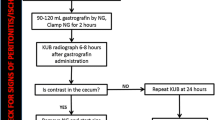Opinion statement
Percutaneous gastrostomy tube placement is a technically feasible and safe procedure for palliation in patients with small bowel obstruction (SBO) caused by advanced gynecologic malignancies. It is used commonly in patients who are poor surgical candidates, those who elect to not undergo surgery, and in patients with a limited lifespan because of end-stage cancer. Percutaneous gastrostomy tube placement is even technically possible in patients with tumor encasing the stomach, diffuse carcinomatosis, and ascites. Percutaneous endoscopic gastrostomy (PEG) tubes provide symptomatic relief of nausea and vomiting in most patients with advanced gynecologic cancer and SBO. PEG tube placement allows most patients to have end-of-life care at home or in an inpatient hospice. It is a cost effective procedure and is associated with low morbidity and mortality. Placement of PEG tubes should be highly considered in patients who present with recurrent bowel obstruction and who have undergone a prior operation for SBO in the setting of advanced gynecologic malignancy.
Similar content being viewed by others
References and Recommended Reading
Baines MJ: The pathophysiology and management of malignant intestinal obstruction. In Oxford Textbook of Palliative Medicine. Edited by Doyle D, Hanks GWC, MacDonald N. Oxford: Oxford University Press; 1998:526–534.
Storey PS: Obstruction of the GI tract. Am J Hospice Palliat Care 1991, 8:5.
Mystakidou K, Tsilika E, Kalaidopoulou O, Papadimitriou L: Comparison of octreotide administration vs conservative treatment in the management of inoperable bowel obstruction in patients with far advanced cancer: a randomized, double-blind, controlled clinical trial. Anticancer Res 2002, 22:1187–1192.
Mercadante S, Ripamonti C, Casuccio A, et al.:Comparison of ocreotide and hyoscine butylbromide in controlling gastrointestinal symptoms due to malignant inoperable bowel obstruction. Support Care Cancer 2000, 8:188–191.
Mangigi G, Aletti G, Frigerio L, et al.: Palliative care for intestinal obstruction in recurrent ovarian cancer: a multivariate analysis. Int J Gynecol Cancer 2005, 15:830–835.
Pothuri B, Vaidya A, Aghajanian C, et al.: Palliative surgery for bowel obstruction in recurrent ovarian cancer: an updated series. Gynecol Oncol 2003, 89:306–313.
Pothuri B, Meyer L, Gerardi M, et al.: Reoperation for palliation of recurrent malignant bowel obstruction in ovarian carcinoma. Gynecol Oncol 2004, 95:193–195.
Campagnutta E, Cannizzaro R: Percutaneous endoscopic gastrostomy (PEG) in palliative treatment of non-operable intestinal obstruction due to gynecologic cancer: a review. Eur J Gynaecol Oncol 2000, 4:397–402. This review provides useful background data regarding PEG tube placement and includes smaller studies that are not present in this paper.
Ponsky JL, Gauderer MW: Percutaneous endoscopic gastrostomy: a nonoperative technique for feeding gastrostomy. Gastrointest Endosc 1981, 27:9–11.
Malone JM Jr, Koonce T, Larson DM, et al.: Palliation of small bowel obstruction by percutaneous gastrostomy in patients with progressive ovarian carcinoma. Obstet Gynecol 1986, 68:431–433.
Stellato TA, Gauderer MW: Percutaneous endoscopic gastrostomy for gastrointestinal decompression. Ann Surg 1987, 205:119–122.
Levin DC, Matteucci T: “Turf battles” over imaging and interventional procedures in community hospitals: survey results. Radiology 1990, 176:321–324.
Wollman B, D’Agostino HB, Walus-Wigle JR, et al.:Radiolgoic, endoscopic, and surgical gastrostomy: an institutional evaluation and meta-analsysis of the literature. Radiology 1995, 197:669–704.
Hoffer EK, Cosgrove JM, Levin DQ, et al.: Radiologic gastrojejunostomy and percutaneous endoscopic gastrostomy: a prospective, randomized comparison. J Vasc Interv Radiol 1999, 10:413–420.
Silas AM, Pearce LF, Lestina LS, et al.: Percutaneous radiologic gastrostomy versus percutaneous enodscopic gastrostomy: a comparison of indications, complications and outcomes in 370 patients. Eur J Radiol 2005, 56:84–90.
Cannizzaro R, Bortoluzzi F, Valentini M, et al.: Percutaneous endoscopic gastrostomy as a decompressive technique in bowel obstruction due to abdominal carcinomatosis. Endoscopy 1995, 27:317–320.
Bleck JS, Reiss B, Gebel M, et al.: Percutaneous sonographic gastrostomy: method, indications, and problems. Am J Gastroenterol 1998, 93:941–945.
Lee MJ, Saini S, Brink JA, et al.: Maligant small bowel obstruction and ascites: not a contraindication to percutaneous gastrostomy. Clin Radiol 1991, 44:332–334.
PothuriB, Montemarano M, Gerardi M, et al.: Percutaneous endoscopic gastrostomy tube placement in patients with malignant bowel obstruction due to ovarian carcinoma. Gynecol Oncol 2005, 96:330–334. This is the largest single series of PEG tube placement in patients with malignant obstruction from a gynecologic malignancy and has the most thorough follow-up data.
Ryan JM, Hahn PF, Mueller PR: Performing radiologic gastrostomy or gastrojejunostomy in patients with malignant ascites. AJR Am J Roentgenol 1998, 171:1003–1006.
Cunningham MJ, Bromberg C, Kredentser D, et al.:Percutaneous gastrostomy for decompression in patients with advanced gynecologic malignancies. Gynecol Oncol 1995, 59:273–276.
Campagnutta E, Cannizzao R, Gallo A, et al.: Palliative treatment of upper intestinal obstruction by gynecological malignancy: the usefulness of percutaneous endoscopic gastrostomy. Gynecol Oncol 1996, 62:103–105. This series, although small, has good follow-up data and discusses the use of octreotide in conjunction with PEG tube for symptomatic relief.
Kozarek RA, Ball TJ, Ryan JA: When push comes to shove: a comparison between two methods of percutaneous endoscopic gastrostomy. Am J Gastroenterol 1986, 81:642–646.
Marks WH, Perkal M, Swhwartz P: Percutaneous endoscopic gastrostomy for gastric decompression in metastatic gynecologic malignancies. Surg Gynecol Obstet 1993, 177:573–576.
Gossner L, Keymling J, Hahn EG, et al.: Antibiotic prophylaxis in percutaneous endoscopic gastrostomy (PEG): a prospective randomized clinical trial. Endoscopy 1999, 31:119–124.
Kulling D, Sonnenberg A, Fried M, et al.: Cost analysis of antibiotic prophylaxis for PEG. Gastrointest Endosc 2000, 51:152–156.
Herman L, Hoskins W, Shike M: Percutaneous endoscopic gastrostomy for decompression of the stomach and small bowel. Gastrointest Endosc 1992, 38:314–318.
Galat SA, Gerig KD, Porter JA, et al.:Management of premature removal of the percutaneous gastrostomy. Am Surg 1990, 56:733–736.
Calton W, Martindale R, Gooden S: Complications of percutaneous endoscopic gastrostomy. Mil Med 1992, 157:358–360.
Campagnutta E, Cannizzao R: Percutaneous endoscopic gastrostomy (PEG) in palliate treatment of non-operable intestinal obstruction due to gynecologic cancer: a review. Eur J Gynaecol Oncol 2000, 21:397–402.
Author information
Authors and Affiliations
Rights and permissions
About this article
Cite this article
Meyer, L., Pothuri, B. Decompressive percutaneous gastrostomy tube use in gynecologic malignancies. Curr. Treat. Options in Oncol. 7, 111–120 (2006). https://doi.org/10.1007/s11864-006-0046-1
Issue Date:
DOI: https://doi.org/10.1007/s11864-006-0046-1




